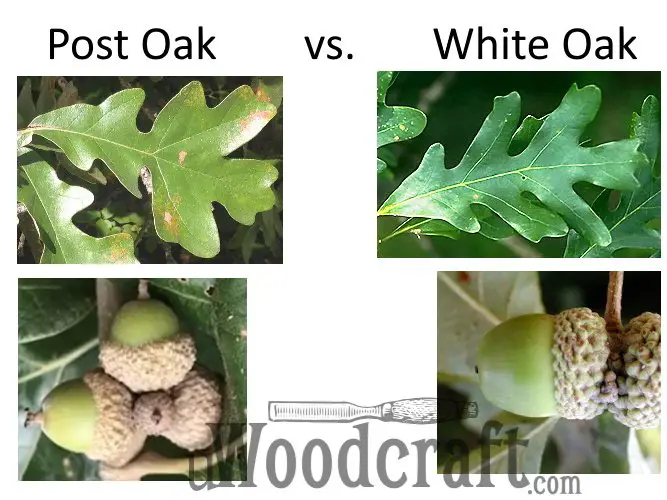
If you’re interested in woodworking, you already know that oak is one of the strongest woods available, but there are also different types of oak that can affect the project you’re working on.
There are more than 500 species of oak trees, which includes both white oak and post oak.
If you’re wondering what post oak is, or what the differences are between post oak and white oak, you’re in the right place.
What Are Oak Trees?
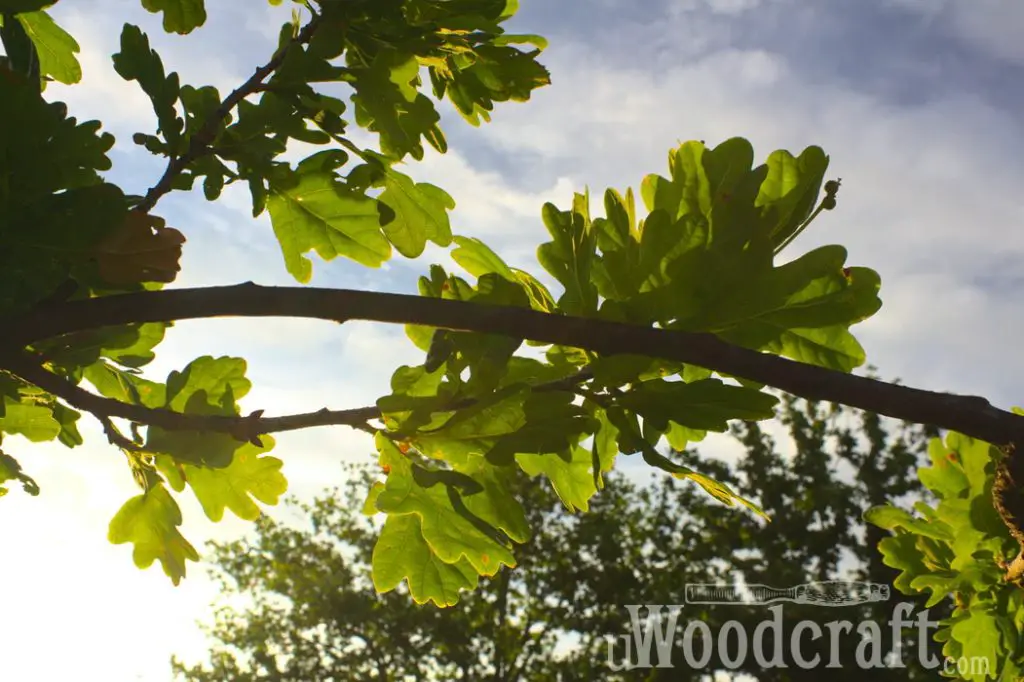
Oak trees are part of the beech family in the genus Quercus, and they can be trees or shrubs.
North America contains the most species of oak trees, with 90 species in the United States alone. Mexico is home to 160 species, while China has roughly 100.
Oak wood is very dense at around 0.43 ounces/cubic inch, so it is a very strong and hard wood. These days, oak wood is commonly used in furniture, timber-frame buildings, flooring, and even barrels for aging wine and other alcohol.
One of the things that makes oak trees so unique is how long they live. On average, oak trees live 150 years or more, although there are some that have been around 1,000 or even 1,500 years.
Post Oak Trees: The Basics
Both post oak trees and white oak trees are in the group known as white oak.
Post oak got its name because this type of wood is often used to make fence posts.
This is in fact a great type of wood to make posts out of, mainly because it is resistant to decay and usually lasts for decades.
Post oak and white oak have the same density and hardness, but post oak is roughly 10% weaker and 20% more bendable than white oak. This is the main reason why most post oak is not used to make furniture or cabinets.
There is a type of post oak that is sometimes used to make some furniture and cabinets. It is found in the bottomlands in eastern Texas, and in the Mississippi River valley in western Mississippi, southeastern Arkansas, and Louisiana.
Known as Delta post oak, it is often used for cabinet-making and furniture.
Another type of post oak, called sand post oak, does the same thing and is found in southeastern Virginia, south to central Florida, and west to eastern Oklahoma, as well as in south and central Texas.
Post oak, or Quercus stellata trees, usually stand from 33 to 49 feet tall and have trunks that are roughly one to three feet in diameter. Other uses for post oak include stair risers, veneers, construction timbers, and particleboard.
The nuts (acorns) make the perfect food for wildlife such as squirrels, deer, and turkey, although they are toxic to cattle because of their tannin content.
Parts of the Post Oak Tree
Just like any other tree, post oak trees have unique characteristics when it comes to their leaves, nuts, and so on.
The leaves of the post oak tree are a very distinct, cross-like shape and usually have five lobes, with the two in the middle being opposite. They are four to seven inches long and three to four inches wide.
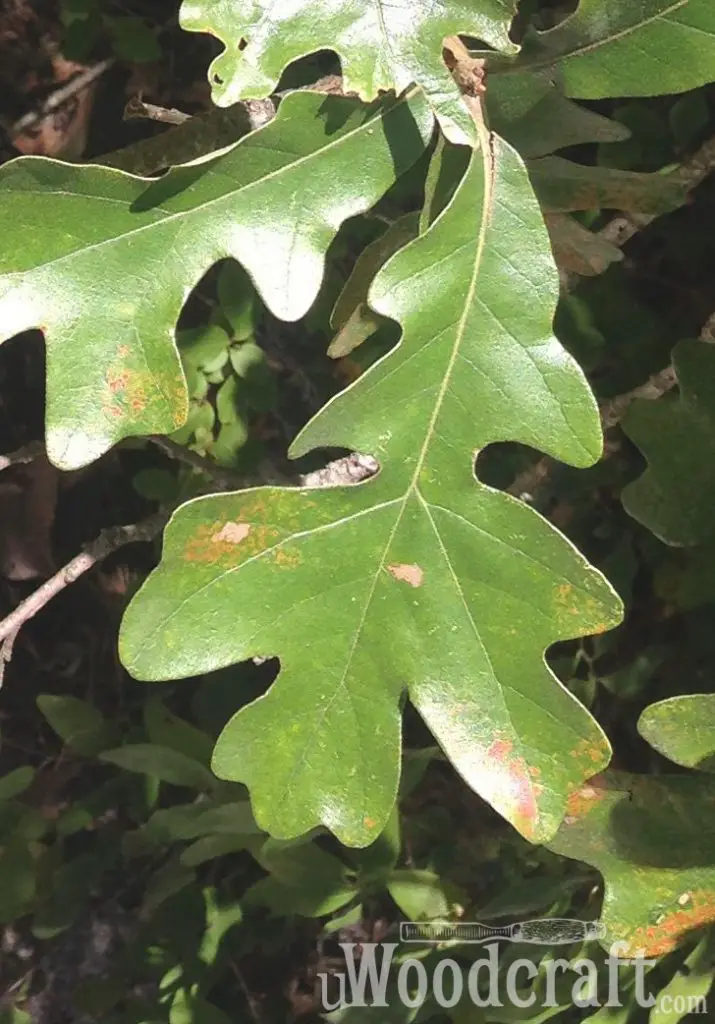
The leaves are also rather leathery and dark green in color.
In April or May, flowering occurs and there are both male and female flowers on the tree.
The male flowers are larger than the females.
The acorns in a post oak tree usually arrive in September or October, and they are roughly 0.80 inches long. They mature during their very first summer.
If you’re anxious to see the post oak’s acorns, you’ll have to be patient. It often takes up to 25 years to see the first crop of acorns.
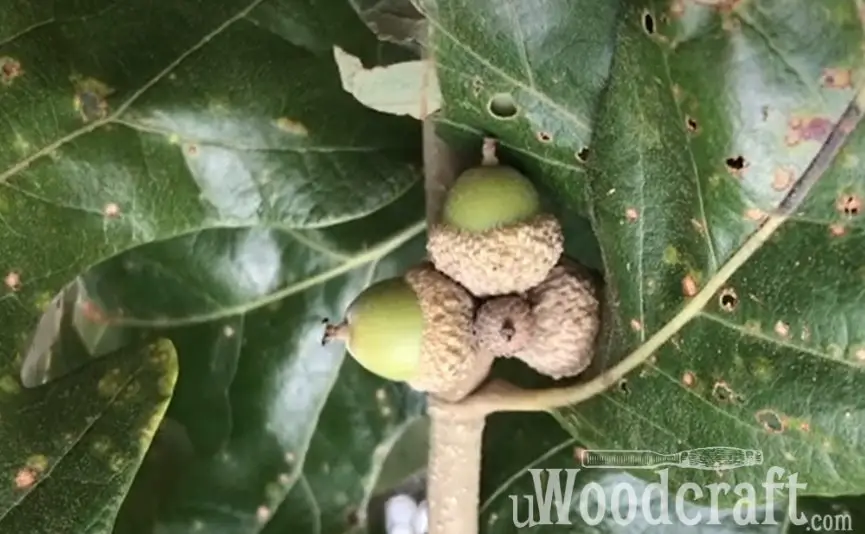
When the post oak tree is young, its bark is smooth and light brown in color. It is elevated narrowly near the oak tree itself.
Over time, the bark gets both darker and a little rougher.
Using Post Oak for Cooking / Smoking Food
If you’re looking for a good type of wood to smoke foods with, post oak is a good choice because it gives your meat a taste that is slightly sweet and an almost vanilla flavor. In fact, many people compare the flavor to Kentucky bourbon.
It also burns slowly and for a very long time, and when you’re smoking foods, a long slow burn is always best.
Challenges of Growing & Maintaining Post Oak Trees
Although considered easy to grow, post oak trees are also susceptible to certain diseases, most notably chestnut blight, oak wilt, and powdery mildew, among others.
Other potential problems include insect pests such as galls, oak lace bugs, nut weevils, scale, and borers, to name a few.
That being said, most people consider this a low-maintenance tree that doesn’t suffer with problems very often.
That’s a good thing because the post oak tree has a maximum lifespan of 400 years, so your tree could be around for the rest of your life.
Other Post Oak Facts & Characteristics
Post oak trees are also called iron oaks, and they grow slowly and mostly in dry areas on the tops of ridges and on the edges of fields.
Post oaks can also grow in poor soils and are resistant to drought, rot, and fire. In fact, their ability to survive fires is one of the main reasons they stay around for so long.
If you’re in central Texas and get invited to a barbecue, don’t be surprised if this is the type of wood they use on the smoker or grill.
The grain of post oak wood is fairly coarse, and it has medium to large pores.
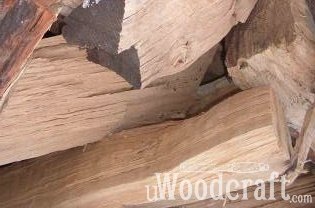
If you’re using post oak to build something, you’ll find it very easy to glue and it takes all types of finishes and stains very well. The scent of the wood is typical for oak trees, with most people finding it a very pleasant smell.
Post oak is also a little more expensive than red oak but overall, it is a moderately priced wood choice. If you choose thicker 8/4 planks or quarter sawn boards, they are usually a little pricier.
If you’re looking for a good shade tree to plant in your yard, the post oak is a great suggestion. They grow best when planted in US growing zones 5 through 9 and when planted in an area that receives a lot of sun.
It is also a low-maintenance tree and is easy to grow, in part because you can grow it successfully in soil that is damp or even on the dry side.
All oak trees, including the post oak, are known for their ability to provide great shade. You’ll often see post oak trees lining parks, recreation areas, and even city streets.
White Oak Trees: The Basics
White oak trees are also called Quercus alba trees, but oddly enough, they are usually light gray and not white in color.
They are found mostly in the eastern United States and are much larger than the post oak tree, getting up to 65 to 85 feet high, sometimes much higher. They have trunks with a diameter of three to four feet.
White oak is very strong and attractive. It is also resistant to rot and economical, making it a very popular type of oak with professional woodworkers.
It is also easy to work with and can be used to make items such as furniture, cabinetry, flooring, boats, interior trim, and veneer.
White oak has a straight grain and a texture that is coarse and uneven.

Uses of the White Oak Tree
The white oak tree has acorns that are consumed not only by wildlife such as squirrels, deer, and rabbits, but also by humans.
Banjos and many other musical instruments can be made out of white oak, and the bark of the tree has medicinal purposes, such as making teas that are good for bronchitis, colds, coughs, fevers, and even diarrhea.
Woodworkers often use white oak for items such as barrels, tubes, buckets, and wooden casks, and the Japanese use it for certain martial arts weapons, such as the jo and bokken.
Other White Oak Facts & Characteristics
White oak trees usually live for 200 to 300 years, although just like other oak trees, they can live longer than that in some instances.
The leaves of the white oak tree are 4 to 8.5 inches long and 2.75 to 4.5 inches in width. They are simple leaves that are arranged alternatively on the stems of the branches. The upper part of the leaves is a bluish-green color and has an underside that is more of a whitish-green color.
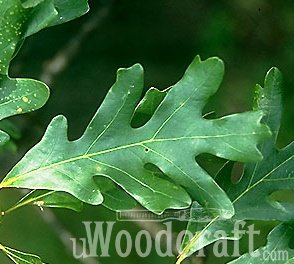
The flowers of the white oak tree appear in May and are monoecious. They are 2.5 to 3 inches long, and there are both male and female flowers.
The male flowers are a yellow-green color, while the female flowers are more of a reddish-green color.
White oak acorns grow to roughly one inch long and fall in early October. They look a bit different than other oak trees because the acorns on a white oak tree have caps that look “bubbly.”
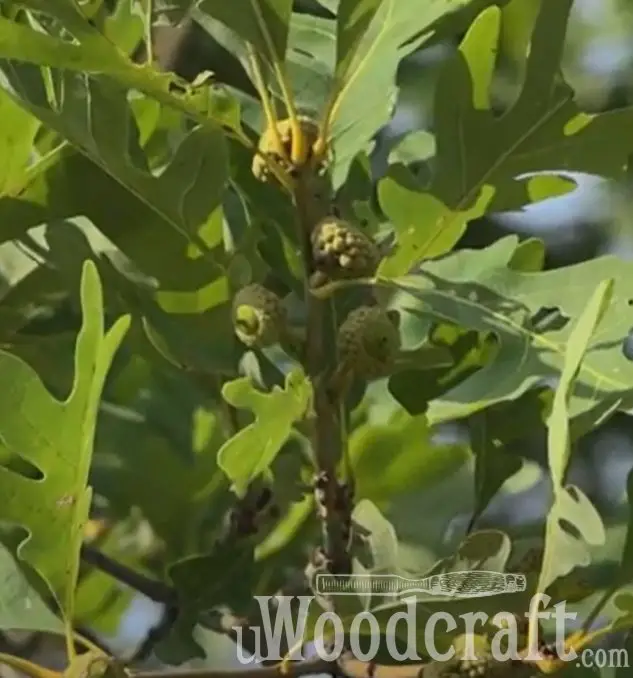
While the bark of the white oak tree is usually not white, it is a light-gray color and sometimes is dark gray instead.
But the bark actually starts out a lot darker, coming in at bright green, then a reddish-green, and finally a light-brown color.
Distribution of White Oak
Since the white oak tree is tolerant of both dry and moist soils and both acidic and alkaline soils, it can be found in a variety of places, including valleys, ridges, and everything in between.
While it is considered a lowland tree, it can also be found in the Appalachian Mountains up to around 5,200 feet.
The white oak tree grows slowly but grows quite large, which is why it isn’t cultivated as an ornamental tree like other oak trees are.
In addition, because it has a large taproot, it doesn’t take urban pollution and road salt very well, which is why you seldom see it lining city streets or parks.
Compared to most other oak trees, the white oak tree has small acorns that are usually more bitter in taste than oaks such as the red oak.
Certain wildlife eat the acorns of the white oak tree, especially wood ducks, jays, thrushes, deer, and nuthatches; however, humans can only eat them if they do not taste bitter. A bitter taste means there is dangerous tannin inside of the acorns.
Some of the most well-known and oldest white oak trees include the following:
- Wye oak tree in Wye Mills, Maryland, which was estimated to be more than 450 years old when it fell in a thunderstorm in 2002.
- Great White oak tree in Basking Ridge, New Jersey, which was estimated to be more than 600 years old when it died in 2016. This tree measured 75 feet tall and 25 feet in circumference at the base.
- “Shawshank” tree from the movie The Shawshank Redemption, which was more than 200 years old when it fell in 2016.
- Bedford oak tree in Bedford, New York, estimated to be around 500 years old and is still going strong.
Post Oak vs. White Oak – Conclusion
The white oak tree has a distinct aroma just like other oaks do, with most people considering it a very pleasing scent.
In woodworking, white oak does well whether you’re working with hand tools or machine tools.
It can react with iron when it’s wet and cause discoloration and staining.
That being said, white oak responds well to steam-bending and stains, finishes, and glues quite well.
Since the wood is very durable and resistant to rot, it can be used in items such as boats and in tight cooperage applications.
White oak is readily available and comes in a lot of different thicknesses and widths, so the prices are usually moderate and affordable.
Although rare, white oak does cause sensitivities and certain reactions in some people, including skin and eye irritation and asthma-like symptoms.
White oak wood is used frequently in cabinetry and in furniture making, and it is the state tree of Maryland, Connecticut, and Illinois.
The white oak tree grows slowly, so it is difficult for it to be transplanted somewhere else, which makes a full-grown white oak tree even more valuable.
